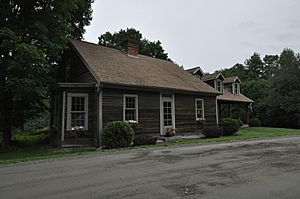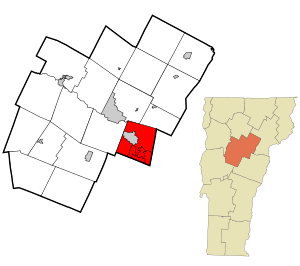Barre (town), Vermont facts for kids
Quick facts for kids
Barre, Vermont
|
|
|---|---|
 |
|

Location in Washington County and the state of Vermont
|
|
| Country | United States |
| State | Vermont |
| County | Washington |
| Communities |
|
| Area | |
| • Total | 30.7 sq mi (79.5 km2) |
| • Land | 30.6 sq mi (79.4 km2) |
| • Water | 0.1 sq mi (0.1 km2) |
| Elevation | 988 ft (301 m) |
| Population
(2020)
|
|
| • Total | 7,923 |
| • Density | 258/sq mi (99.8/km2) |
| Time zone | UTC-5 (Eastern (EST)) |
| • Summer (DST) | UTC-4 (EDT) |
| ZIP Codes | |
| Area code(s) | 802 |
| FIPS code | 50-03250 |
| GNIS feature ID | 1462036 |
Barre (/ˈbæri/ BARR-ee) is a town in Washington County, Vermont, United States. The population was 7,923 at the 2020 census, making it the 3rd largest municipality in Washington County and the 16th largest municipality in Vermont. Popularly referred to as "Barre Town", the town of Barre almost completely surrounds "Barre City", which is a separate municipality. The original town now known as Barre was first chartered in 1780 as the Town of Wildersburgh. In 1793 the name Wildersburgh was unpopular with the inhabitants and the name of the town was changed to Barre. In 1895 the City of Barre was incorporated and separated from the town of Barre, and both continue to exist as separate municipalities.
Contents
Geography
According to the United States Census Bureau, the town has a total area of 30.7 square miles (79.5 km2), of which 30.6 square miles (79.4 km2) is land and 0.1 square mile (0.1 km2) (0.16%) is water. Barre is the self-proclaimed "Granite Center of the World". Initially established with the discovery of vast granite deposits at Millstone Hill soon after the War of 1812, the granite industry and the town itself saw a boom with the arrival of the railroad. The fame of this vast deposit of granite, which some geologists say is 4 miles (6.4 km) long, 2 miles (3.2 km) wide and 10 miles (16 km) deep, soon spread to Europe and Canada. Large numbers of people migrated to Barre from Italy, Scotland, Spain, Scandinavia, Greece, Lebanon, Canada, and a number of other countries. The population increased from 2,060 in 1880, to 6,790 in 1890, to 10,000 in 1894. Millstone Hill and the nearby Barre Town Forest are now the site of a recreational, wooded trail network, where the mining holes and grout piles are still peppered throughout.
Demographics
| Historical population | |||
|---|---|---|---|
| Census | Pop. | %± | |
| 1800 | 919 | — | |
| 1810 | 1,669 | 81.6% | |
| 1820 | 1,955 | 17.1% | |
| 1830 | 2,012 | 2.9% | |
| 1840 | 2,126 | 5.7% | |
| 1850 | 1,845 | −13.2% | |
| 1860 | 1,839 | −0.3% | |
| 1870 | 1,882 | 2.3% | |
| 1880 | 2,060 | 9.5% | |
| 1890 | 6,812 | 230.7% | |
| 1900 | 3,346 | −50.9% | |
| 1910 | 4,194 | 25.3% | |
| 1920 | 3,882 | −7.4% | |
| 1930 | 4,280 | 10.3% | |
| 1940 | 4,052 | −5.3% | |
| 1950 | 4,145 | 2.3% | |
| 1960 | 4,580 | 10.5% | |
| 1970 | 6,509 | 42.1% | |
| 1980 | 7,090 | 8.9% | |
| 1990 | 7,411 | 4.5% | |
| 2000 | 7,602 | 2.6% | |
| 2010 | 7,924 | 4.2% | |
| 2020 | 7,923 | 0.0% | |
| U.S. Decennial Census | |||
As of the census of 2000, there were 7,602 people, 2,951 households, and 2,216 families residing in the town. The population density was 248.1 people per square mile (95.8/km2). There were 3,046 housing units at an average density of 99.4 per square mile (38.4/km2). The racial makeup of the town was 98.47% White, 0.18% Black or African American, 0.09% Native American, 0.29% Asian, 0.18% from other races, and 0.78% from two or more races. Hispanic or Latino of any race were 1.51% of the population.
There were 2,951 households, out of which 34.4% had children under the age of 18 living with them, 64.0% were couples living together and joined in either marriage or civil union, 7.6% had a female householder with no husband present, and 24.9% were non-families. 20.3% of all households were made up of individuals, and 8.9% had someone living alone who was 65 years of age or older. The average household size was 2.57 and the average family size was 2.95.
In the town, the population was spread out, with 25.6% under the age of 18, 6.1% from 18 to 24, 27.7% from 25 to 44, 26.7% from 45 to 64, and 13.9% who were 65 years of age or older. The median age was 40 years. For every 100 females, there were 94.7 males. For every 100 females age 18 and over, there were 93.4 males.
The median income for a household in the town was $46,563, and the median income for a family was $53,565. Males had a median income of $32,873 versus $26,061 for females. The per capita income for the town was $21,609. About 3.7% of families and 5.2% of the population were below the poverty line, including 6.9% of those under age 18 and 1.9% of those age 65 or over.
Education
Barre Town has its own public school, Barre Town Middle and Elementary School, which hosts students from pre-school through grade eight. The public high school is Spaulding High School and is located in Barre City. Also located in Barre Town are the Websterville Christian Academy and the Montessori School of Central Vermont.
Notable people
- Jodi Cilley, film producer, educator and entrepreneur
- Lui Collins, singer-songwriter (folk)
- Madelyn Davidson, Vermont State Treasurer
- A. Clarke Dodge (1834–1916), Wisconsin businessman and politician
- Norman Dubie, poet
- D. C. Jarvis (1881–1966), physician
- Miranda July, performance artist, musician, writer, and film director
- Dave Moody, NASCAR commentator
- Katherine Paterson, Newbery Award-winning author of books for children
- Tracey Poirier, Vermont National Guard brigadier general
- Helen Bonchek Schneyer, folk musician
See also
 In Spanish: Barre (condado de Washington, Vermont) para niños
In Spanish: Barre (condado de Washington, Vermont) para niños


